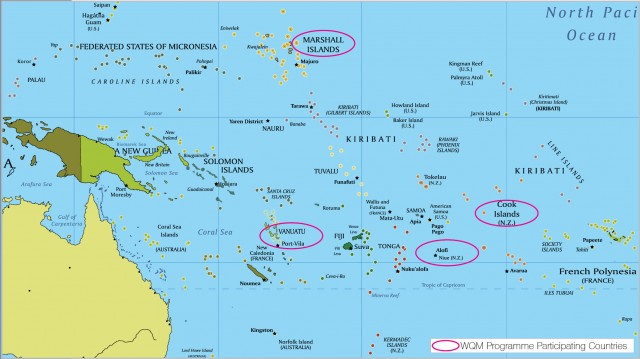Cook Islands
PART OF NEW ZEALAND, the Cook Islands consist of 15 islands in the south PACIFIC OCEAN, about halfway between HAWAII and NEW ZEALAND. They are about the same size as RHODE ISLAND. The islands are scattered over an area of more than 706,566 square mi (1.83 million square km). The nine islands in the southern group were formed by volcanic material escaping from a fracture in the Earth's crust. Most of the population lives on these fertile islands. The northern islands are low coral atolls. The mountainous Rarotonga in the southern group is the largest island.
The Cook Islands have a tropical climate, moderated by trade winds, similar to Hawaii's climate. It is often sunny, and the rains, although sometimes heavy, don't last long. Hurricanes can occur during their summer, from December to March. The interior of Rarotonga is the wettest place in the islands. The highest temperatures, averaging 84 degrees F (29 degrees C), occur during the wet season. In the coolest months, the average daily high temperature is 77 degrees F (25 degrees C). Lush vegetation grows on the Cook Islands. Tall trees, creepers, and ferns grow in the interior. Food plants, such as coconuts, bananas, and grapefruit are found on the coast. Yams and taro are important food crops.

Most Cook Islanders are of Polynesian background, although a few people are a mix of Polynesian and other cultures. The Polynesians belong to the Maori branch of the Polynesian race and are related to the Maoris of New Zealand. The official languages are English and Maori, and most people speak both. The overwhelming majority of the people are Christian. Most belong to the Cook Islands Christian Church, founded in the 1820s by missionaries. Cook Islanders are excellent dancers. Traditional music is also popular. Islanders compete in dance and singing competitions. String bands use a combination of electronics and traditional instruments fashioned from coconut shells. Visitors can choose from a large selection of arts and crafts made by the Islanders. Popular items include coconut-fiber hats, brightly-colored wraparound clothing, wood carvings, and pottery. Woven mats and blankets are also in demand, as are carved bowls.
Avarua, located on Rarotonga, is the nation's capital and largest town. Although it is a typical small tropical town, it boasts a gallery, the National Cultural Centre, and a branch of the University of the South Pacific. A number of small villages are scattered around the islands.
The Cook Islands have been occupied by the Polynesians for 1,500 years. Captain James Cook discovered some of the islands in 1773. Missionaries from London, converted most of the islanders to Christianity. The islands were a British protectorate from 1888 until 1901, when they were annexed by New Zealand. Although still officially a part of New Zealand, the islands are self-governing.